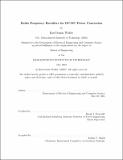Radio frequency rectifiers for DC-DC power conversion
Author(s)
Wahby, Riad Samir, 1981-
DownloadFull printable version (573.5Kb)
Alternative title
Radio frequency rectifiers for direct current-direct current power conversion
Other Contributors
Massachusetts Institute of Technology. Dept. of Electrical Engineering and Computer Science.
Advisor
David J. Perreault.
Terms of use
Metadata
Show full item recordAbstract
A significant factor driving the development of power conversion technology is the need to increase performance while reducing size and improving efficiency. In addition, there is a desire to increase the level of integration of DC-DC converters in order to take advantage of the cost and other benefits of batch fabrication techniques. While advances in the power density and integration of DC-DC converters have been realized through development of better active device technologies, much room for improvement remains in the size and fabrication of passive components. To achieve these improvements, a substantial increase in operating frequency is needed, since intermediate energy storage requirements are inversely proportional to frequency. Unfortunately, traditional power conversion techniques are ill-suited to handle this dramatic escalation of switching frequency. New architectures have been proposed which promise to deliver radical performance improvements while potentially reaching microwave frequencies. These new architectures promise to enable substantial miniaturization of DC-DC converters and to permit much a higher degree of integration. The principal effort of this thesis is the development of design and characterization methods for rectifier topologies amenable to use in the new architectures. A computational design approach allowing fast and accurate circuit analysis and synthesis is developed and applied, along with traditional analysis, to two demonstrative rectifier topologies. In addition, the application of coupled magnetic structures for parasitic mitigation is considered. Experimental implementations are investigated to verify analytic and computational results.
Description
Thesis (M. Eng.)--Massachusetts Institute of Technology, Dept. of Electrical Engineering and Computer Science, 2004. Includes bibliographical references (p. 75-78). This electronic version was submitted by the student author. The certified thesis is available in the Institute Archives and Special Collections.
Date issued
2004Department
Massachusetts Institute of Technology. Department of Electrical Engineering and Computer SciencePublisher
Massachusetts Institute of Technology
Keywords
Electrical Engineering and Computer Science.